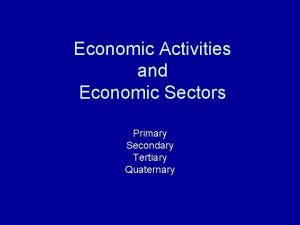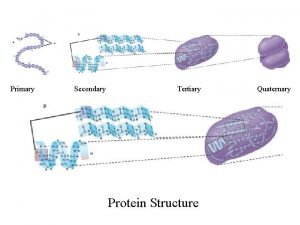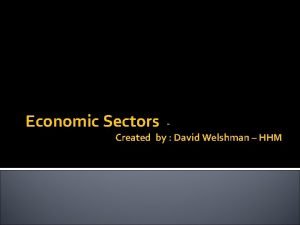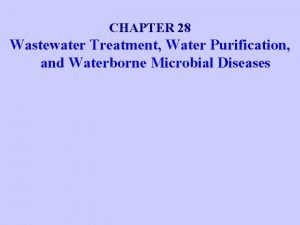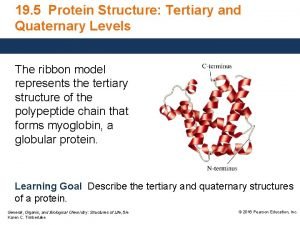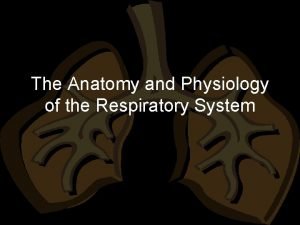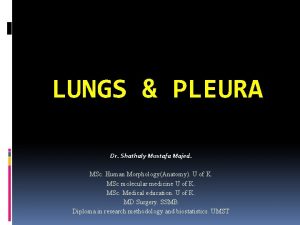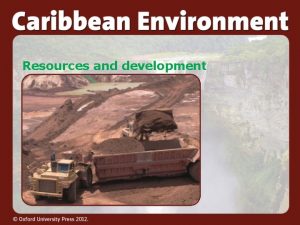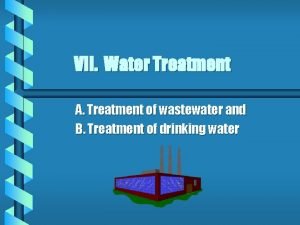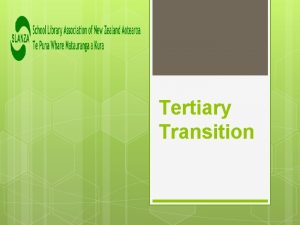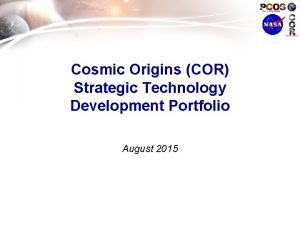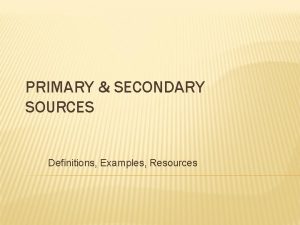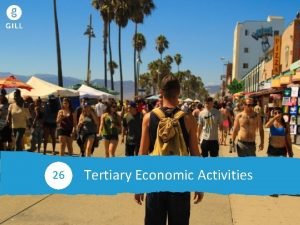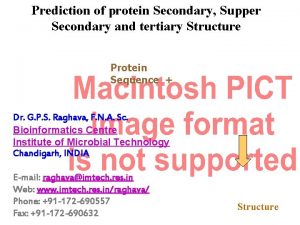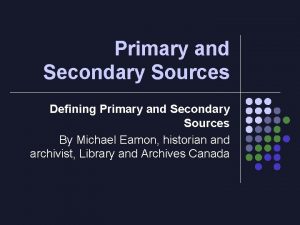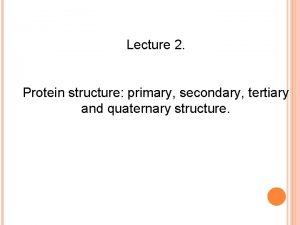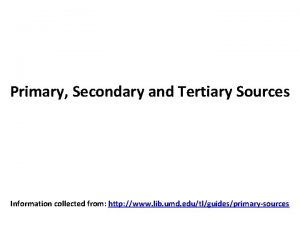Resources and development Primary secondary and tertiary activities


















- Slides: 18

Resources and development

Primary, secondary and tertiary activities Natural resources include minerals, agricultural resources such as soil, and biotic resources such as forests or fish. Primary activities make direct use of natural resources. They include agriculture, forestry, fishing and mining. Secondary activities include manufacturing industries which produce processed or assembled goods. Construction, and utilities such as water supply, are also secondary industries. Tertiary activities produce services, not goods. Transportation, retailing, health care, entertainment and tourism are service industries. Most jobs are now in service industries.

The changing economy Until the mid-twentieth century, the Caribbean depended on primary industries such as sugar cultivation and mining. Secondary and tertiary industries are now important, such as: § tourism § manufacturing § health services and education § banking and financial services. Fewer people now work in agriculture. Most jobs are now in service industries, such as government services and retailing. All industries create jobs, earn foreign exchange and pay taxes.

How employment in Barbados has changed Which sectors have grown in importance? Which have declined?

Key concepts in development (1) Gross domestic product or GDP: This is the total value of goods and services produced. Countries such as the USA and China have a large GDP. Per capita GDP: This is the average GDP for each person in a country. Small wealthy countries such as Bermuda have a high per capita GDP. Human development: Development includes human and social progress as well as wealth. The human development index looks at factors such as education, health or pollution.

Key concepts in development (2) Globalisation: Countries are now closely linked by trade, travel, the internet. Large companies plan their activities on a global basis. Globalisation has positive and negative effects. Sustainable development: Development which does not damage the environment, and takes social needs such as health and education into account. The aim is a pattern of growth which can be sustained to benefit future generations. Renewable resources: Resources such as forests, rivers, marine life and the soil are renewable. If they are used wisely, they will remain productive for the future. However, they may be damaged by misuse. Non-renewable resources, such as oil or bauxite, will eventually run out.

Fishing in Belize: a resource-based primary industry § Rivers bring nutrients to the sea. § Shallow waters hold nutrients for marine life. § Coastal mangroves shelter young fish. § Crustaceans and fish and thrive on coral reefs. The barrier reef is 280 km long. § There are deepwater fishing grounds further offshore, beyond the reef.

Fishing co-operatives Fisheries make up 13% of Belizean exports. Most fishers belong to a cooperative. Co-operatives buy catch from fishers, process it, and find an export market. The profits are shared. Co-operatives lend funds for new equipment, and pay for pensions.

Conservation and sustainability § Fish stocks must be carefully managed. Worldwide, grouper, and some types of tuna are threatened with extinction. § Threats include over-fishing, destruction of mangroves, pollution from pesticides, and damaging fishing methods. § Conservation requires scientific understanding of food sources, breeding patterns, pollution, nutrients and other factors. § In Belize, there are closed seasons to protect young conch and lobster. Groupers and some other species are protected by law. § Trawlers are banned because they damage the seabed. Cooperatives have an annual quota or maximum catch. § Protected areas and marine reserves conserve marine habitats. Belize has internationally recognised marine heritage sites.

Aquaculture or fish farming § Aquaculture makes up over 36% of world fisheries. § Belize has five large shrimp farms. Warm temperatures; a salt water supply; clay soil to retain water; labour; and good roads all assist production. § Fish and shrimp are given high-protein feed. § Oxygen, temperature, chemicals and food safety are carefully managed.

Bauxite and aluminium Bauxite is an ore which contains aluminium oxide. A refinery processes bauxite to make alumina, or pure aluminium oxide. Alumina is smelted to make aluminium, using a powerful flow of electricity. Aluminium is a metal, used to make aircraft, cooking foil and many other products.

Bauxite production: the worldwide picture What proportion was produced by Jamaica, Guyana and Suriname in 1965? And in 2009? Which is today’s leading producer?

Bauxite mining in Jamaica § Mines in western Jamaica produce bauxite. § Most is processed locally in alumina plants, and moved by rail to exports. § Jamaica’s location close to North America was an advantage, but most smelters are now elsewhere. § Mining and labour costs are high by world standards.

Bauxite mining in Guyana § There are mines at Linden and Aroaima. There is no alumina plant in Guyana. § A white sand overburden must be removed, increasing mining costs. § Guyana produces highvalue pure bauxite, used for firebricks, anti-skid surfaces etc. Some is also used to make aluminium. § Shipping difficulties increase transport costs.

Oil and natural gas: exploration and production § Oil and natural gas are extracted from rocks deep beneath the land surface or seabed. § In oil or gas traps, impermeable rocks prevent seepage to the surface. § A seismic survey identifies possible traps. Drilling a test well to confirm a find may cost up to US$100 m. § When a find is confirmed, more investment is needed to start production.

Oil and natural gas in Trinidad and Tobago Most oil and gas is produced from marine fields off the east and north coasts. Oil and gas are moved onshore by pipeline.

How oil and gas are processed and used Trinidad and Tobago extracts only 0. 2% of the world’s oil and 1. 4% of natural gas. Oil is refined at Pointe à Pierre on the west coast. Uses of natural gas include: § electricity generation § manufacturing chemicals and steel for export § making Liquefied Natural Gas, chilled to -161 °C for export by tanker.

Fisheries, bauxite, oil and gas, and the future Fishing industries in Belize use renewable resources. If these are well-managed and conserved, production can continue in the future. Threats include damage to coral reefs (see Chapter 18). Jamaica has enough bauxite to last for at least fifty years. The main threat to the industry is from high mining and processing costs. Costs could be reduced if natural gas or another fuel replaced imported oil for alumina plants. Some mines and plants were closed in 2009, when aluminium prices were low. Oil and natural gas provide 36% of Trinidad and Tobago’s GDP, 48% of taxes and 87% of exports. Known gas reserves will last until around 2029, but more may be discovered. For a secure future, other activities are needed to diversify the economy.
 Primary activities and tertiary activities
Primary activities and tertiary activities What is tertiary economic activity
What is tertiary economic activity Tertiary alcohol oxidation
Tertiary alcohol oxidation Primary secondary tertiary sources
Primary secondary tertiary sources Secondary to tertiary structure
Secondary to tertiary structure Primary secondary tertiary medical care
Primary secondary tertiary medical care Secondary processing of food
Secondary processing of food Primary secondary and tertiary sector
Primary secondary and tertiary sector Tertiary sector business
Tertiary sector business John martinko
John martinko Primary secondary and tertiary protein structure
Primary secondary and tertiary protein structure Respiratory membrane
Respiratory membrane Physiology of respiration
Physiology of respiration Difference between right and left lung
Difference between right and left lung All about food chains
All about food chains Primary secondary and tertiary industries
Primary secondary and tertiary industries Primary secondary and tertiary industries in belize
Primary secondary and tertiary industries in belize Primary secondary and tertiary structure of protein
Primary secondary and tertiary structure of protein Wastewater treatment process primary secondary tertiary
Wastewater treatment process primary secondary tertiary

